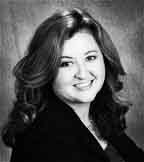 | Marisa Honomichl is Vice President of Marketing and Development at the Kansas Cosmosphere and Space Center in Hutchinson. The Cosmosphere houses one of the largest collections of space artifacts in the world including the Apollo 13 space capsule. The mission of the Cosmosphere is “Honoring the Past and Inspiring the Future of Space Exploration.” This is accomplished through educational programming such as space exploration camps for students in the summer. Feel free to contact the Cosmosphere for more information on their camps and programming at (800)397-0330 or visit www.cosmo.org. |
Science
2009-10-01 15:50:00
Flying into space...a rarity
Answer: Astronauts are a very rare breed. You are more likely to meet an NFL football player in your lifetime than you are to meet a person who has flown into space. One not only has to be talented, educated and exceptional at what they do, they also have to be lucky. As in many things in life, timing is everything and NASA not only looks for The Right Stuff, they are pretty picky about the timing of when they are looking for certain specialties.
Former NASA Astronaut and also a Kansas native, Steve Hawley shared that because he was trained as an astrophysicist and an astronomer, he never dreamed he would have an opportunity to go into space. “I thought you had to be a pilot or in the military” he noted, and for many years that was the case. His timing could not have been better though and according to Hawley, “I didn’t think I had a chance of being accepted but I knew I’d regret it forever if I didn’t try so I did, and much to my surprise they chose me!”
Nearly fifty years ago, the first Kansas Astronaut flew into space, not in a rocket but in an experimental plane. The X-15 was a rocket-boosted aircraft which flew 199 flights with 12 different pilots at the controls from 1959 through 1968. It captured vital data on the effects of hypersonic flight on man and machine that proved invaluable to the nation’s aeronautics researchers, including NASA and developers of the space shuttle.
“It was a real kick in the pants,” shared retired Air Force Major General Joe Engle, and Kansas native, who would later go on to pilot two shuttle missions. “The drop from the B-52 carrier aircraft was pretty abrupt, and then when you lit that rocket a second or two later you definitely felt it,” said Engle, who was a member of the same exclusive fraternity of pilots that included Crossfield and the eventual first man on the moon, Neil Armstrong. All took the X-15 to speeds and altitudes that extended the frontiers of flight. Three times Engle flew an X-15 higher than 50 miles, officially qualifying him for Air Force astronaut wings and giving him a brief moment for viewing the edge of space.
“I didn’t really have time to soak up the view in the X-15 like I did later when I flew the space shuttle,” Engle said. Engle credits the X-15 for laying the foundation for many of the operational techniques of the space shuttle. He credits his opportunity to fly two shuttle missions with good timing though. Engle was scheduled to fly the Apollo 17 mission until the announcement of the cancellation of the Apollo program when NASA decided it was more important to have a geologist on board that mission. Although disappointed, as luck would have it, his experience as an X-15 pilot is what would make him invaluable for testing and eventually flying the shuttle years later.


